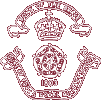


 |
 |
|
 |
||
| Navigation links at the bottom of this page | ||||||
| The School stages Christmas entertainment | ||||||
|
||||||
The photograph was analyzed by a review panel of three (Peter Goble of Harrogate, Yorks, Brian Marley, Hon. Gen. Secretary of the Australian OBA, Melbourne, and the writer). What follows is a synthesis of that review. Three boys in the uniform of the school are in the photograph. The boy seated in the front row has a good conduct stripe on his left sleeve. All three boys wear the 'fore and aft' hat known as a 'forage hat' and introduced some before the (1914-1918) World War. This is a clear indication that the image is a school photograph. The majority of the children in costume are boys. The few girls present were probably daughters of the school staff roped in to add variety to the performance – a likely attempt to add gender balance to the mix. The clearest evidence of the year (1913) the photograph was taken is the presence of Warrant Officer Alfred Fowler (see 1914 An unsung hero) and his wife Lucinda (seated in the second row on Fowler's right hand side. The event was in all likelihood staged near Christmas time of that year because Mr. Fowler left the school in 1914 when appointed Quartermaster of the Liverpool Merchants Mobile Hospital; also, the school was evacuated to Hutton, Essex at the outbreak of the war, so the year could not have been 1914. |
||||||
What about occasion and performance? The banner-bearing children appear to be holding the standards of the colonies and dominions of the empire. The banner second from the left in the rear row seems to represent Fiji; New Zealand and Australia with their stars are in evidence. What are these banners or standards, the wide variety of costumes worn: a trumpeter, soldier of the Empire, sailor, jester, and Britannia in a prominent central position grasping her trident, mistress of the seas? There was disagreement about the hat of the boy, seated in the front row, third from the left, as to whether his hat is Australian or taken from the Boer War. The most likely suggestion for this form of entertainment in the days before radio and television is that this is the assembled company of a 'tableaux vivant' performance, a popular form of entertainment before the First World War. Tableaux vivant, or simply tableau, is French for 'living picture', which involves using performers in suitable costumes and positioning them in striking, often theatrical, poses or arrangements. |
||||||
|
||||||
From the banners displayed and the costumes worn, we speculate that the company in the Duke of York's photograph staged a series of living pictures depicting the width and breadth of the British Empire as it was in 1913. Each picture would perhaps have displayed one dominion or colony at a time for the audience to ponder. Staged living pictures were still in vogue throughout the 1920s and 30s. Even as late as the early post-war years of the Second World War, the tableau vivant formed part of exercises in some teaching colleges such as, for example, the Lincoln Diocesan Teacher College where living picture displays were combined with 'natural movement' dancing. Trainee teachers received group photographs of themselves in Greek costume posing in tableau vivant as shoeless, bare-legged nymphs clad in white diaphanous robes suggesting the purity of vestal virginity. In today's society of acceptable promiscuous levity such displays would be deemed unnecessary except their value as marketing images. In that same era, one of the panel recalls playing the part of "...one of the shepherds who 'washed his socks by night' under the auspicious eye of the late Miss Blackman." By this time, however, part of the performance included vocal numbers and a ditty, he recalls, that has plagued him since. "If a gentleman calls, his horse for to shoe, he makes no denial of one pot of two." Such was the form and development of living picture style entertainment. Those familiar with the premises of the Duke of York's School might be interested in our conclusion as to where the 'performance' was held. That the stage was purpose-built for the occasion is fairly evident, for there was at the time no auditorium on the property with a built-in stage. Although it is not possible to place the location with certainty there were two possibilities. One was the assembly hall in the main school building, the other the gymnasium. A clue to the assembly hall would have been its parquet floor, which would have been protected with covering material. This is not evident. The floor shows timber flooring of four inch planks, which suggests the stage area to have been at the rear of the gymnasium facing the main door. On this evidence, the panel opted for the school gymnasium and hope that Ms. Fiona Archontoulis would be satisfied with this explanation of her family photograph. |
| ||||||||||
|
© A. W. Cockerill 2011 Site Map Contact me | ||||||||||